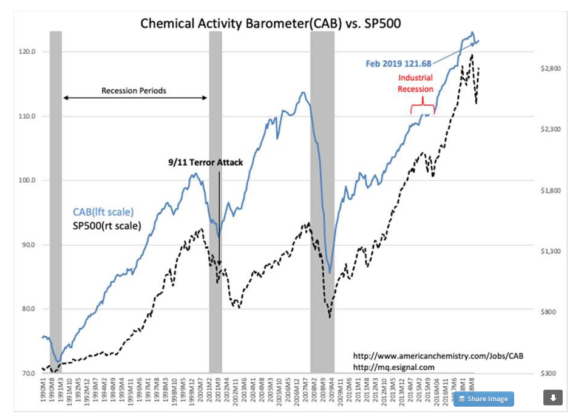“Davidson” submits:
The Chemical Activity Barometer(CAB) has turned higher. The last 3mos of data have been revised higher. One should have expected this knowing that this index includes chemical company stock data. The market panic of Oct-Dec 2018 drove some chemical company shares lower by as much as 60%(from early Oct). Those shares have already recovered by as much as 70%(from the lows). This is how panics can influence indices and misinform investors unless one takes the time to piece together that share prices driven by market psychology often ignore economic fundamentals. The CAB uses share prices as only part of its input with the rest coming from various sources including industry production and hours worked. News reports from Jan 31, 2019 and Feb 25, 2019 indicated that production remained in uptrends.
The continued strength in the CAB is good evidence for a full recovery from the recent panic and higher equity prices beyond that. The Great Depression analogies of 2mos ago were simply a self-induced panic without economic evidence. This was a “Panic Bubble”. Bubbles in pricing come and go frequently often without notice by most investors. Value-oriented investors sensitive to fundamentals recognize that they occur relatively often and use down-drafts like the one we just experienced as a buying opportunity.
Markets remain decidedly depressed relative to fundamentals. Markets remain a good buying opportunity.
https://www.americanchemistry.com
“The CAB comprises indicators relating to the production of chlorine and other alkalies, pigments, plastic resins and other selected basic industrial chemicals; chemical company stock data; hours worked in chemicals; publicly sourced, chemical price information; end-use (or customer) industry sales-to-inventories; and several broader leading economic measures (building permits and new orders).”
“WASHINGTON (February 25, 2019) – U.S. production of major plastic resins totaled 7.7 billion pounds during December 2018, an increase of 5.3 percent compared to the same month in 2017, according to statistics released today by the American Chemistry Council (ACC).”
“WASHINGTON (January 31, 2019) – Data collected and tabulated by the American Chemistry Council (ACC) reveal that global chemicals production rose 0.3 percent in December. This follows stable activity in November, a 0.1 percent gain in October, and weak activity in August and September.”
